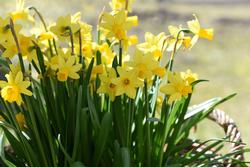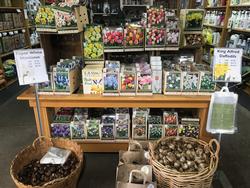With a little care your flowering bulbs can rebloom each year
-
Marty Nelson
-
Now is the time when it’s easy to be enticed by catalog photos and nursery displays of spring flowering bulbs. Nothing signals spring like the emergence of bright yellow daffodils or fragrant hyacinths and there are many varieties available. While it’s possible to treat bulbs as annuals and replace them every fall, they are designed to provide multiple seasons of bloom. With minimal care they will provide spring color for many years. That’s bad news for the bulb industry but good news for lazy gardeners.
 Daffodils, also called narcissus or jonquils, grow from true bulbs and thrive with minimal attention. Photo credit: peakpx.com
Daffodils, also called narcissus or jonquils, grow from true bulbs and thrive with minimal attention. Photo credit: peakpx.comBulb is a general term referring to an underground plant structure that stores food and energy during the time the plant is dormant. Narcissus and tulips form true bulbs, but freesias and crocus grow from corms (squat stems), iris and callas develop rhizomes (bulb-like structures that grow horizontally in the soil), and anemones and alstroemerias sprout from tubers or tuberous roots (fleshy stem bases or roots). Knowing the bulb type is important in planting and propagation.
The growth cycle of a bulb begins at the end of dormancy, after the bulb has had time to replenish the nutrients used during the previous blooming period. Bulbs are usually purchased and planted while they are dormant. In Marin’s Mediterranean climate, the cool temperatures and rain in late fall and winter trigger the next growing phase. It’s not necessary to dig up dormant bulbs to protect them from freezing as it is in colder climates. Some bulbs, however, such as tulips, need more winter cooling and benefit from a period of refrigeration during the dormant phase. Many bulb varieties found in nurseries and catalogs will bring spring color year after year. Photo: Marty Nelson
Many bulb varieties found in nurseries and catalogs will bring spring color year after year. Photo: Marty NelsonAt the beginning of the growth cycle, all the activity is underground while the bulbs form new roots. The growing cycle becomes more active in the spring as temperatures rise and the bulbs begin to send up small shoots that eventually develop into flowering plants. When those showy blooms are emerging, the plant is also engaged in below ground reproduction. Depending on the type of bulb, offsets, tubers, or runners form in preparation for propagation. While the flowers also produce seeds, few gardeners want to wait several years for the bulbs to form. It’s best to remove the flowers before they form seeds in order to conserve the plant’s vitality but leave the foliage in place until it fades and dries naturally. Bulbs depend on photosynthesis from the leaves to restore the energy expended during blooming. Surrounding non-thirsty plants can camouflage the drying foliage.
The right amount of water at the right time is critical for bulbs. Bulbs need water while they are growing actively. When first planted or when rainfall is low, supplemental watering may be required. Too much water, however, can cause bulbs to rot, so good drainage is essential. When bulbs go dormant after blooming, it’s time to stop watering. After blooming, let foliage fade and dry in place so the bulbs can store food for next year's growth. Photo: Marty Nelson
After blooming, let foliage fade and dry in place so the bulbs can store food for next year's growth. Photo: Marty NelsonBulbs can get crowded after several years of growing and multiplying. If you notice a decrease in blooms or multiple stems, your bulbs may be asking for more space. You’ll need to dig them up at the beginning of dormancy and separate out the baby bulbs or tubers. Rhizomes should be divided into sections with each having a bud or eye. The parent rhizome will no longer flower and should be removed. Your bonus bulbs can then be planted to bring you more flowers in the years to come or they can be gifted to fellow gardeners. Remember to follow planting depths – normally plant two to three times deep as the bulb is tall. Add 2-3 inches of mulch to maintain moisture while the bulb grows. Timing is important because newly planted bulbs typically need at least twelve weeks of growing to bloom successfully. During the period of shoot emergence to full flowering, apply fertilizer monthly. The UC Marin Master Gardeners site has more information at marinmg.ucanr.edu/care/planting/plantbulbs.
Once you find out how easy it is to care for bulbs, you’ll want to keep them growing and reproducing. You might even be inspired to try some new varieties so don’t throw away those catalogs just yet.



